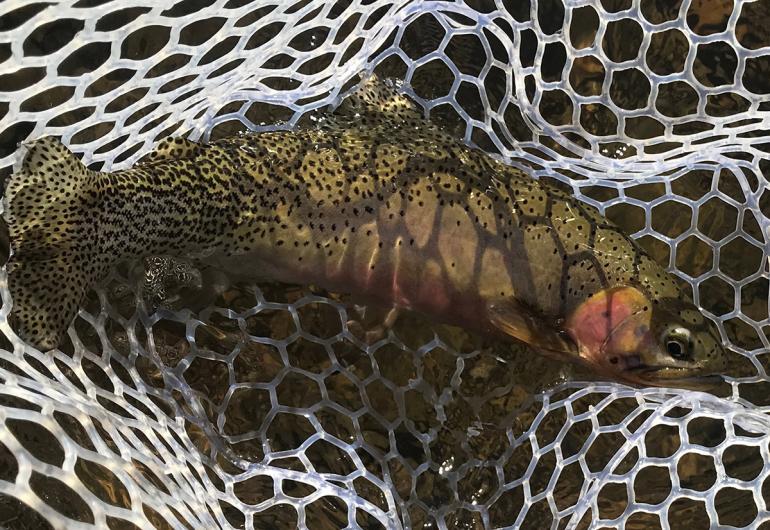Catch and Release the Right Way
Every Montana angler with a conscience should keep in mind that fishing is a brutal sport. Imagine, sitting down to enjoy a nice cheeseburger, you learn your meal is not only made of yarn, but loaded with a hook and line that proceeds to drag you into a foreign environment where suffocation awaits. That’s what you’re doing every time you catch a trout—which is fine, if you’re going to swiftly kill the fish and eat it for dinner. But if you plan to release it, your responsibility as an angler and sentient life form is not only to make the practice as gentle as possible, but also to allow the sport to continue by ensuring their survival. Here are some tips to make that happen:
Use Appropriate Gear
Always employ tackle that minimizes injury to the fish. Barbless hooks are a great option; experience shows that with proper technique (tight line, solid hook-set, etc.), few fish are lost by going barbless. Also, make sure the rod and line you’re using is matched to the fish you’re trying to hook. For instance, going after lake trout with 4-lb test and an ultralight rod would be dumb, as would sending little brookies airborne with a burly 8-weight.
Stay Sharp
Being alert and ready for a strike is the kindest gift an angler can give to a fish. Most fish have a subtle bite, and by paying close attention you will not only bring in more fish, but you’ll lip-hook them instead of deep-hooking them.
Land Them Fast
Survival rate decreases as fight time increases. A fish played too long may not recover; in addition to simple over-exertion, lactic acid build-up in the fish’s muscle tissue causes the cells to decompose. This can also adversely affect the flavor of the meat in fish you keep.
Stay in the Water
Handle the fish as little as possible. Using hemostats (forceps) or needlenose pliers, an experienced angler can remove a barbless hook from the fish without touching it at all—aspire to such heights. Net your fish if it’s the only way to control it; just make sure to use cotton mesh or rubber, as these materials are less harmful to scales, gills, and eyes. If you must remove the fish from the water, do so as gently as possible, and make sure to WET YOUR HANDS first. This protects the fish’s slime coating, which helps prevent infection by waterborne disease, among other benefits. A good rule of thumb when removing a fish from water is to hold your breath at the same time. When you need to breathe, the fish does too. If your hook-removal or photo-op takes longer than a few seconds, put it back in the water for a few moments before continuing.
Do not suspend fish (especially large fish) by the line, lower jaw, or gills, as this places enormous strain on the throat-latch and will most likely result in fatal injuries. And never, ever, lift a fish out of the water by holding the belly area. You will almost certainly damage internal organs and dramatically decrease the likelihood of survival. Place your hand flat and lift the fish out of the water on its side.
Unhook Quickly and Carefully
A long, sloppy unhooking results in a dead fishy. Use the tools mentioned above to quickly and efficiently remove the hook. If you can’t remove the hook with your release tools, cut it near the bend with wire cutters and snip the line as close to the fly as possible. Fish have strong digestive acids that dissolve metal. Studies have shown that fish released in this manner have a higher survival rate than fish that have had hooks torn from their throat or stomach.
If the fish has obviously swallowed the bait, cut the line off as close to the mouth as possible and allow the fish to swim away. The fish may be able to get rid of the hook itself if it has no barb, or it will dissolve over time. Never pull on the line of a deep-hooked fish as this will severely injure the fish and will probably kill it. And when in doubt, keep the fish and eat it. A trout in your stomach is far better than one floating belly-up in the river.
Weigh Your Fish with a Ruler
If you absolutely must know how big your fish is, measure it quickly with a ruler and release it. Don’t use portable scales as they can injure the fish in several ways, including tearing the gill cover and damaging the internal organs. The following formulas can be used to estimate weight.
Trout: Length x girth x girth divided by 800
Walleye: Length x length x length divided by 2,700
Bass: Length x length x length divided by 1,200
Pike: Length x length x length divided by 3,500
Release with Care
Revive the fish before releasing it. Gently hold it upright underwater by the tail and cradle its underside if necessary. Hold the fish facing the current when in a river or gently move the fish back and forth in still water to help move water through the gills. Be patient and give the fish as much time as it needs to recover and swim away on its own—it’s the least you can do.
Remember, fishing is a sport that we enjoy at the expense of another animal, so it’s up to us to maintain the balance between their survival and our time spent driving hooks through their faces. As Harold Blaisdell wrote in The Philosophical Fisherman, “All the romance of trout fishing exists in the mind of the angler and is in no way shared by the fish.” That being said, a one-sided romance is a romance nonetheless, however unbalanced. Spring hath come and the fish are hungry! Get out there, get after it, just be gentle.
Check out the painting "Catch and Release" by local artist Parks Reece in our digital edition here.












